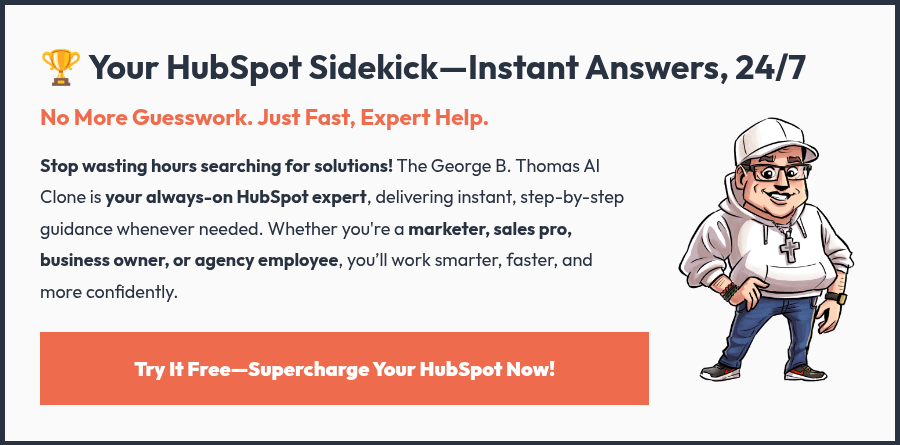The hype around AI and content creation is ... well, let's just call it a "spectrum," shall we? I've heard everything from “AI will revolutionize content creation!” to simply “Just let AI handle it—it’s fast and easy!” But let’s pump the brakes for a second. While AI is a powerful tool, it’s not the magic wand some people make it out to be. And here’s the real kicker: if we’re not careful, we could actually misuse AI in ways that hurt, rather than help, our content efforts.
When I look at AI, I see so much opportunity.
However, there’s a reason so many people are wary of AI.
We’ve all seen those cringe-worthy, robot-like blog posts that lack any sort of heart, humor, or personality. That’s because a lot of folks think AI is some all-in-one solution that can replace human creativity. Spoiler alert: it can’t. Sure, AI can churn out words, but it doesn’t know how to weave a story or connect emotionally with an audience. And if you let AI take the wheel without human oversight, you end up with generic, soulless content that does more harm than good.
🚀 Go Deeper: Check Out HubSpot's #INBOUND24 AI-Powered Product Updates
But why does this fear exist? Why are we so worried about AI taking over? It comes down to how AI is marketed and, more importantly, how it’s often misused. We hear promises of “fast, easy, and do-it-all-for-you” solutions, and while that sounds great, it can lead to bad habits—like relying on AI to do the hard work we should be doing ourselves.
That’s when things go off the rails. The heart of good content is, and always will be, humanity. AI can assist, but it can’t replace your voice, your creativity, or your understanding of your audience.
In this article, we’re going to explore how to use AI the right way—to assist you, not replace you. I’ll show you how to harness the power of AI to make your content creation smarter and more efficient without losing the personal touches that make your content resonate. Here’s what we’ll cover:
- Why AI should assist you, not take over your creative process.
- How to give AI the context it needs to actually be helpful.
- The importance of iteration and feedback to refine AI’s outputs.
- How to offload the boring stuff so you can focus on what really matters—your creativity.
- Why the right mindset is key to making AI a true partner in your content process.
By the end of this, you’ll know how to make AI work with you, not against you, so you can create content that’s not just efficient, but also human, authentic, and impactful. Let’s dive in.
1. AI Is Your Assistant, Not Your Replacement
Think of AI like a shiny new gadget you get over the holidays. At first, it’s kind of cool, but you’re not quite sure how it fits into your everyday life. But once you figure out its purpose, it starts making things a whole lot easier. That’s how AI works in content creation. It’s not here to replace you—it’s here to assist you. But you need to figure out where it fits and, more importantly, where it doesn’t.
🚀 Go Deeper: Get My Human-Powered, AI-Assisted #INBOUND24 Content Toolkit
Here’s the thing: AI is brilliant at speeding up the early stages of content creation. Whether you’re brainstorming topics, rough drafting blog posts, or optimizing content for SEO, AI can handle the tedious, repetitive tasks and get you past the initial hurdles. But you? You’re still in the driver’s seat.
Let’s get specific.
AI Can’t Replace Your Brand Knowledge
AI doesn’t know your brand the way you do. Sure, it can pull data from across the web, but it doesn’t inherently understand your brand’s unique tone, values, or mission. It’s not going to magically know that your brand has a playful, light-hearted voice that uses humor and pop-culture references. It can’t grasp the subtleties of how your brand speaks to its audience unless you explicitly tell it.
AI Can’t Connect with Your Audience on an Emotional Level
AI can generate text based on data, but it doesn’t feel. And that’s a big deal in content creation. AI doesn’t know how to tell a story that resonates emotionally with your readers. It can’t tap into the shared experiences, pain points, or desires of your audience. It doesn’t know how to make a reader feel seen, understood, or inspired.
AI Can Generate Ideas, But You're the Strategy-Driver
Brainstorming is one of the areas where AI truly shines. You can ask it for a list of blog post ideas, title suggestions, or content outlines, and it’ll pump out a bunch of options in seconds. But here’s the kicker: AI doesn’t understand your content strategy.
It doesn’t know what’s going to move the needle for your business or what fits into the larger narrative you’ve been building with your audience. It can suggest 50 blog post ideas, but you need to filter those through the lens of your goals, your audience’s needs, and where your content fits within the buyer’s journey.
AI Helps You Work Faster, But You Provide the Heart + Soul
AI’s biggest strength is speed. It can draft 1,000 words in a fraction of the time it would take a human. It can sift through mountains of data and spit out an outline in seconds. And when you’re staring at a blank page, that’s a lifesaver. But here’s the thing: speed isn’t the goal. Impact is.
You might have 1,000 words written by AI, but if those words don’t resonate with your audience or reflect your brand’s values, what’s the point? AI can help you get the bones of a piece in place, but you’re the one who has to flesh it out, add the personality, and ensure it aligns with your strategy.
2. Give AI Clear Instructions (Like You Would to a Team Member)
Imagine telling someone on your team to “write something about our new product”—no other details (no strategy, no audience, no context)—and being disappointed when they return with a vague, uninspired result. AI works the same way—AI is smart, but it can’t read your mind. If you give it vague instructions, you’ll get vague results.
To get the best from AI, you need to provide clear, detailed instructions. For example, asking AI to “write an email” will produce a generic result. But if you say, “Write a 300-word email for small business owners about the importance of email marketing, in a casual and engaging tone,” the output will be far more useful and relevant.
🚀 Go Deeper: Liz's Human-Powered, AI-Assisted Inbound Content Framework
Why does this matter? Because AI doesn’t inherently understand your brand, audience, or tone. You need to give it context. Is your audience a small business owner or a corporate executive? Do they prefer a friendly, conversational tone or something more formal? These details matter. If you don’t specify, AI will default to generic language, and your content will miss the mark.
Think of AI like a new team member: the more precise you are with instructions, the better the result. Instead of “write a blog post on email marketing,” say, “create a 500-word post for small business owners explaining three simple email marketing strategies, in a helpful and approachable tone.” You’re guiding AI to deliver exactly what you need.
Pro Tip: Be specific. The more context and details you provide—about the audience, tone, and goal—the better your output will be.
3. AI Needs (+ Loves) Feedback to Improve
Just because AI spits out a first draft doesn’t mean the work is done. Think of AI as that super-enthusiastic intern who shows up on the first day with tons of energy, but still needs a little coaching to get the job done right. AI is excellent at getting ideas on the page quickly, but it needs your guidance, your refinements, and yes, your feedback to turn that rough draft into something truly polished.
One of the biggest misconceptions about AI is that it can deliver perfect, ready-to-go content right out of the gate. The reality is AI works best as a starting point, not a finishing line. It can give you a draft that’s structurally sound, but it might miss the mark on tone, emotional depth, or brand alignment. That’s where you come in. Your role is to shape the output, inject personality, and ensure it aligns with your vision.
🚀 Go Deeper: Get My Human-Powered, AI-Assisted #INBOUND24 Content Toolkit
And here’s the best part: AI learns from the feedback you provide. If the content feels flat, off-brand, or lacking that human touch, don’t scrap it—go back and adjust the prompts.
Maybe the tone was too formal or the examples didn’t resonate with your audience. Tweak the instructions, give it a bit more context, and watch how AI adjusts. It’s a process of continuous refinement, just like coaching that intern. The more you engage with it, the better the results.
Feedback isn’t just a nice-to-have; it’s essential. Each round of tweaks gets you closer to the result you’re looking for, and over time, you’ll find that AI starts getting better at delivering content that feels right on the first try.
Pro Tip: Don’t be afraid to iterate! Give AI feedback just like you would with any first draft—adjust, refine, and guide it until it hits the mark.
4. Automate the Boring Stuff, So You Can Focus on Creativity
Not all parts of content creation are exciting. Whether it’s cranking out meta descriptions, optimizing for SEO, or formatting endless variations of social posts, some tasks are just plain tedious. And this is where AI really shines. AI can handle the repetitive, time-consuming parts of content creation that often feel like a grind, freeing you up to focus on the fun stuff—being creative.
Think of AI as your personal assistant that never gets tired of the boring, mundane tasks. Need 10 different headline options for your blog post? AI can generate them in seconds. Have a 2,000-word article that needs summarizing? AI’s got that covered too. Want to quickly turn a blog post into a handful of social media snippets? You guessed it—AI can do that too.
🚀 Go Deeper: Check Out HubSpot's #INBOUND24 AI-Powered Product Updates
The beauty of this is that by offloading these repetitive tasks to AI, you can save a ton of time and mental energy. Time that you can now invest in the parts of content creation that truly require your human touch—like brainstorming new ideas, crafting compelling stories, and refining the messaging to ensure it resonates with your audience.
However, don’t mistake “automation” for “autopilot.” AI can handle the heavy lifting on the backend, but it still needs you to review, refine, and ensure that everything aligns with your brand’s voice and goals. Automation is about making your life easier, not replacing your oversight. When you’re no longer bogged down by formatting or keyword optimization, you can focus on what you do best—bringing creativity and strategy to the forefront of your content.
Pro Tip: Use AI to streamline repetitive tasks like SEO optimization, formatting, or generating variations of content, but always make sure to give it a final human touch before hitting publish.
5. The Right Mindset: You’re the Star of the Show
When it comes to using AI in content creation, having the right mindset is everything. AI is a tool—an incredibly powerful one—but it’s not the magic solution to all your content needs. The key to getting the most out of AI is recognizing that while it can assist, you’re still the one who brings the creativity, strategy, and vision to the table. You’re still the star of the show.
Think of it like this: AI can help you get from point A to point B faster, but you decide the direction, the tone, and the heart of the content. AI might help you brainstorm ideas, create outlines, or even generate a first draft, but it’s not going to tell a story that deeply connects with your audience or aligns perfectly with your brand’s values. That’s your role.
🚀 Go Deeper: Get My Human-Powered, AI-Assisted #INBOUND24 Content Toolkit
The mistake some people make is viewing AI as a “set it and forget it” solution. They assume AI will handle everything—ideation, writing, editing, and even publishing—without human intervention. This mindset leads to robotic, cookie-cutter content that lacks the human touch. It’s critical to remember that AI is here to amplify your skills, not replace them.
The best results come when you approach AI with the mindset that it’s a tool for enhancement, not replacement. It’s here to help you scale your efforts, work more efficiently, and get through the mundane tasks faster, but at the end of the day, you’re still the one driving the strategy. It’s your creativity, your understanding of your audience, and your expertise that make the difference between average content and content that resonates.
Pro Tip: Always approach AI as an assistant, not a substitute. The right mindset—where you use AI to streamline processes without giving up control of your content’s heart and soul—will lead to far better results.
Use Your New AI Superpowers Responsibly
Yes, AI can handle the heavy lifting—whether that’s drafting, optimizing, or automating—but it’s your creativity, your voice, and your connection to your audience that give your content its soul. By embracing AI as an assistant, providing it with clear instructions, refining its output with thoughtful feedback, and using it to automate the tedious tasks, you can unlock the full potential of AI without sacrificing the human element that makes your content special.
Now is the time to take control and make AI work for you, not against you. You have the tools, the knowledge, and the creativity to elevate your content and reach new heights. So, what’s next? To help you integrate everything we’ve talked about today, I’ve put together a free AI Content Toolkit that will walk you through step-by-step how to start using AI effectively in your content strategy. It’s packed with tips, templates, and actionable strategies to help you create content that’s faster, smarter, and more human.
Make AI your new favorite sidekick—and keep your humanity at the heart of everything you do.


 George B. Thomas
George B. Thomas

